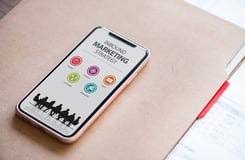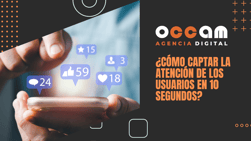Index Content
For any marketing strategy to work, including inbound marketing, it is essential to establish the complete customer journey. This is what a sales funnel is all about, and we are here to help you find out what makes it essential and what its stages are.
what is a sales funnel?
The sales funnel, also known as a sales funnel, is a methodology used by marketing specialists to classify users in the different stages they go through, classifying all the stages from when the user first comes into contact with the brand, the acquisition, until they make a purchase linked to it and become a customer.
The funnel shape is due to the fact that users are lost at each stage, i.e. the number of users decreases because not all of them complete the buyer's journey.
The sales funnel is not just superficial: its objective is not simply to capture leads, but also to accompany them through the following steps until they become customers. Therefore, its benefits are multiple, from reducing the cost of acquiring potential customers to increasing the purchase frequency or average purchase frequency of those who are already customers.
The parts of the sales funnel
Knowing what stage each user is in, it is easier to design effective strategies to guide them to the next stages of the funnel. Now, let's take a closer look at the parts of the funnel:
-
Top of the funnel (TOFU)
This is the top of the funnel. It is the attraction phase and the one that encompasses the largest flow of user traffic. During this phase, your role is to create content that brings your products and services closer to interested users, those who are looking to solve a problem or satisfy a need.
-
Middle of the funnel (MOFU)
This stage, located in the middle of the funnel, is the conversion phase. Here, your website visitors start to become leads. They already know the products or services you offer, and also what they need to solve the problem that brought them to you, so they are potential customers. Your actions in this part should aim to achieve their full conversion.
-
Bottom of the funnel (BOFU)
The last phase, where your competitors come into play, and you must seek to differentiate yourself from them in order to convince the potential customer that your company is the best option to meet their needs. Your commercial strategies must come into play to finally convert the customer.
The stages of the sales funnel
-
Lead acquisition
Before you start designing your sales funnel, you must have identified your ideal customer. You must generate a semi-fictional representation of your ideal customer, also known as a buyer persona. Mixing real data, obtained from the analysis of existing customers, with educated guesses, describe their demographic information and behaviour, as well as their goals and motivations.
Once you have your buyer persona, the first phase of your sales funnel will be lead acquisition. A lead is a contact who sent you their training, either through a chat on your website or through some kind of form.
Therefore, lead generation consists of identifying visitors to your site and then attracting them with various tools. The aim is for the user to interact with your website and leave their contact details, so that you can use them in the other stages of the sales funnel.
One of the methods used to generate that first attraction of the user is the creation of useful and quality content to make available to them. You should also exploit the potential of your social networks, your advertising and your email marketing, among other tools. In this way, you make yourself known and strengthen the presence of your brand, making it visible in your sector and making it easier for users who might be interested to reach you.
-
Prospect
Now that you already have information about the leads generated in the acquisition process, you already have your prospects. A prospect is any visitor to your website who provides you with their general data or who, for example, registers on your blog or subscribes to your newsletter. Classify and segment them so that you can then design strategies that meet their needs and characteristics.
Marketing automation allows you to make content available to your leads that is appropriate to their actions with respect to your company. You can, for example, programme certain tools to be activated when they complete certain actions such as downloading certain content or requesting more information.
At this stage, you should find out which of your prospects are likely to become potential customers for your product or service, so you don't spend time on those who have no interest in what you have to offer.
-
Opportunity
For the opportunity stage, you wait for prospects to show their interest so that you can offer them your services or products. Finding a sales opportunity involves measuring what they might be interested in from your offer. This way, you can show them only what will bring them value, what fits their needs and what is relevant to them.
-
Qualification
At this point, you have already determined which of your products or services fit the user's needs and, therefore, which one they will be willing to buy. To do this, you have to find out what your potential customer wants through different tools for information gathering. Surveys, phone calls or any other type of conversational strategy fit in this phase.
In addition, you should also pay attention to each of their interactions with your website. Measuring and analysing these interactions allows you to identify what will lead your prospects to become customers, i.e. to make a purchase linked to your brand.
-
Closing
This is the last stage of the sales funnel. When you have identified the product or service that the user needs, start the sales process and finally convert them into a customer. If you have reached this point in the funnel, you have achieved your goal, you have converted your lead into a customer.
Now that you know in depth what the sales funnel is and what its stages are, implement it in your marketing strategy and discover its benefits.

-1.webp?width=200&name=imagotipo_occam%20(1)-1.webp)



